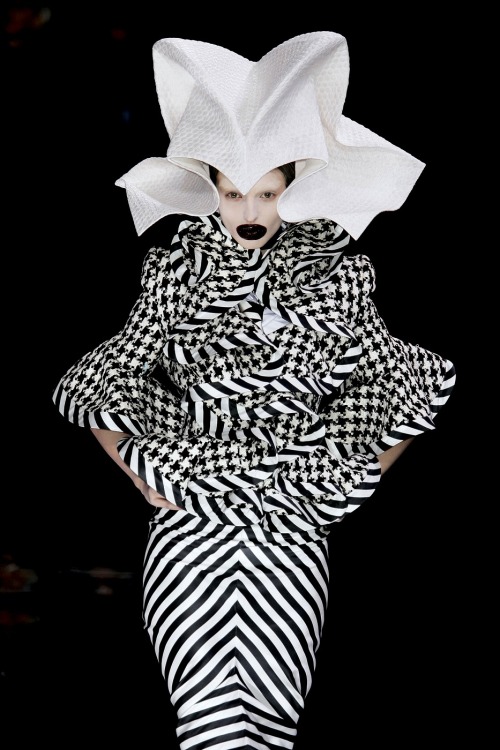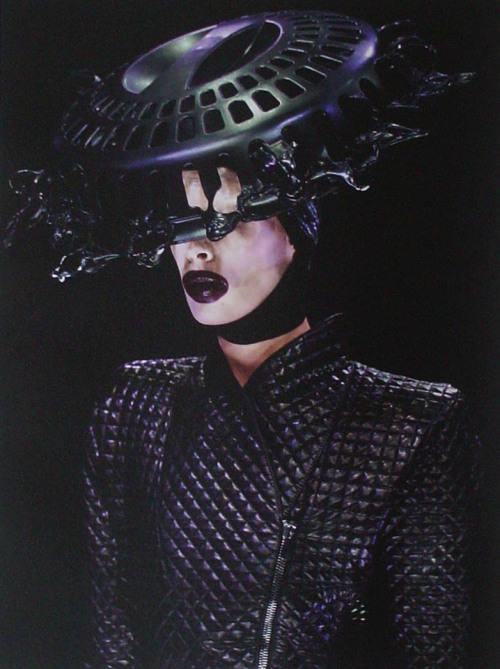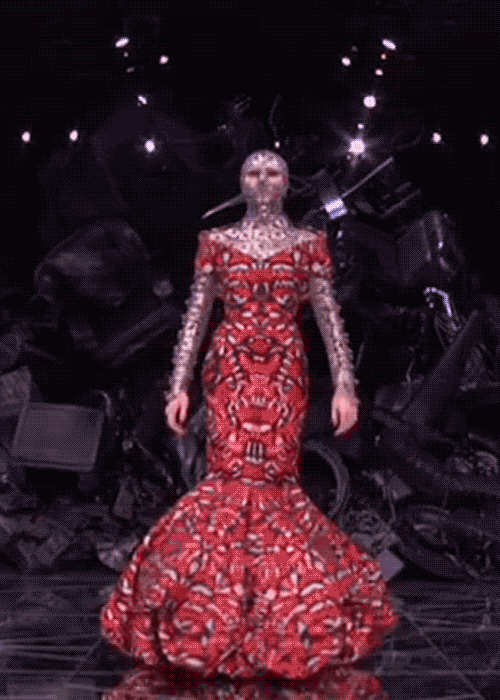Continuing his exploration of the battle between
man and nature, McQueen’s ‘Horn of Plenty’ presentation (which can be seen in
full here) was a return to a more brutal aesthetic for the designer. Taking
place in a vast industrial wasteland, the show’s towering centrepiece was a
scrapheap from which parts had been taken and made into headwear for the
harlequin-faced models. The concept behind the set was that of recycling and
renewal, a concept illustrated by the fact that props from his previous sets
had been taken and spray-painted black in order to populate the scrapheap that
dominated the stage. The designer spoke about how he wanted this show to be a
retrospective of sorts, one that would mark his 15th anniversary in
the fashion industry and enable him to manufacture the image of his legacy – a story
which is particularly poignant considering that this would end up being his
penultimate complete collection.


After playing it safe with his previous offering, McQueen decided to abandon this notion in entirely and showcase excess in all its greatness. The collection consisted mainly of stiff fabrics which had been worked into exquisitely-detailed silhouettes which featured countless ruffles and collars so high that they enveloped the neck entirely. Some of the clothing looked more like an abstract sculpture than something which was ‘ready-to-wear’ – more than ever, McQueen had succeeded in blurring the lines between couture and ready-to-wear with his craftsmanship. Photographer Nick Waplington was invited to visually document the process behind the collection and, in an interview with style.com he revealed that the designer would, unlike his contemporaries, create the garments himself using a roll of fabric and a pair of scissors.
The fabric choices of the collection were also
innovative in their own way - by taking a well-known fabric such as silk and
lacquering it to resemble a broken record was the designer’s own way of
subverting the haute couture tradition, ‘cheapening’ it with materials that
were made to mimic cheap household items. He also paid homage to the couturiers
that had come before him – for example houndstooth was distorted, oversized and
flicked with red but was still an unmistakable nod to Christian Dior, who
became iconic for his use of the print. McQueen’s variation was printed onto
fabrics so stiff that they more closely resembled abstract sculptures than
actual garments, often featuring intricate patterns of protruding ruffles and
necklines so high that they enveloped the models’ necks completely. The
designer also referenced himself by reintroducing the chain-mail bodysuit and
its connected mask which was originally debuted in his A/W 1998 collection ‘Joan’.
This time around the bodysuit was worn under a floor-length printed red dress
whose neckline scooped backwards into an exaggerated cowl and whose hemline was
interrupted by a puff of fabric which kicked outwards from the knees down.
The designer was also self-referential in his
frequent use of bird motifs – most notably, the image of the crow. This
inspiration resulted in the two pieces which closed the show, both of which
were made entirely from lacquered feathers. The first dress consisted of white
feathers which created a tight-fitting pencil dress whose hips were moulded to
emphasise the silhouette. It was accompanied by a white feathered top of sorts
which protruded from the torso of the dress and climbed vertiginously,
obscuring the back of the model’s head and forcing her to cross her arms. The
second was arguably one of the finest pieces of McQueen’s career – made once
again from lacquered feathers, it was moulded to the body and featured two huge
wings which jutted out and literally gave the impression of a crow skulking
along the runway. The designer once stated that he had always wanted to take ‘the
beauty of a bird and transpose it onto a woman’ and, with this, he succeeded.
Overall, the collection has deservedly gone down
as one of the greatest of his career for its re-interpretations of both the
practices of the couture industry as well as re-imaginations of his own
designs. It is this collection in which he pushes both his silhouettes and his
concepts to the limit, creating a set which is almost post-apocalyptic in its
design. The painted faces of the models act as a mask and the colour scheme of
black, white and red hint at a hidden darkness beneath the collection that
McQueen had never commented on. It was the ultimate antithesis of the show that
preceded it and showcased the designer’s unique taste for exaggeration and
melodrama better than any of his previous collections. With perilously high
footwear and headpieces which often masked faces entirely, it was the epitome
of the ‘don’t fuck with me’ look that had become synonymous with the McQueen
woman. It was power dressing at its most extreme and served as the perfect
retrospective to the designer’s turbulent career.





No comments:
Post a Comment